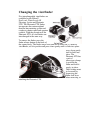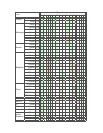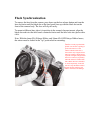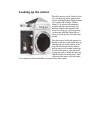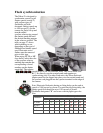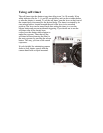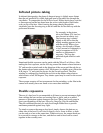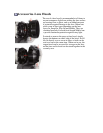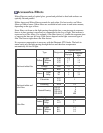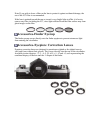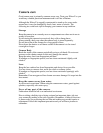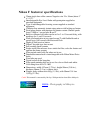
Infrared picture-taking
In infrared photography, the plane of sharpest image is slightly more distant
than the one produced by visible light and seen by the naked eye through the
viewfinder. To compensate for the shTh in focus, Nikkor lenses have a red dot
or line engraved on the lens barrel near the color-coded depth-of-field index
scale on top of the lens. After focusing the image sharply through the
viewfinder, turn the focusing ring to the left until the red dot lines up with the
prefocused distance.
For example, in the picture
below the 50mm f/1.4 lens has
been focused at infinity (oo).
The focusing ring is turned
slightly to the left so that the
infinity marking appears in line
with the red dot When a lens
having a focal length of 50mm
or less (normal or wideangle) is
used at an aperture of f/8 or
smaller, no adjustment is
necessary. The lens has
sufficient depth offield at such
small i apertures to compensate for the shift in focus.
Intentional double exposures can be made with the Nikon F as follows: After
making the first exposure, set the A-R ring around the shutter release button to
"R" and turn the rewind crank in the direction of the arrow until the red dot on
the shutter release button rotates a full 360 degrees (or slightly more). Reset the
A-R ring to "A" and wind the shyster for the second exposure. The film
winding is confirmed by checking the red dot on the shutter release button
which rotates a full 360 degrees. Any shutter speed may be used for the second
exposure.
The exposure counter will not compensate for the rewinding, so the film in the
camera will actually have one frame or two more than indicated.
Double exposures
The use of a lens hood is recommended at all times to prevent extraneous light
from striking the lens surface and causing flare or ghost, and as an added
measure of protection against damage to the lens. Nikon lens hoods come in
four types depending on the lens: Screw-In, Snap-On, Slip-On and Builtln.
They are calculated precisely for each focal-length Nikkor lens to provide
maximum protection against stray light.
To attach or remove the snap-on lens hood, simply depress the buttons on
either side of the hood. It will also fit directly over a screw-in filter, so both
can be used on a lens at the same time. When not in use, the snapon hood can
be reversed for storage on the lens, and the lens and its hood can be stored
together in the eveready case.




